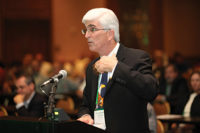When you are in the middle of a code-change cycle, the IAPMO Annual Conference is somewhat melodramatic. In many ways, nothing truly significant can occur regarding the code changes. However, there is an opportunity to present your position and obtain a membership vote.
IAPMO has published the Report on Proposals for the Uniform Plumbing Code and Uniform Mechanical Code. If you haven’t downloaded the files, I suggest you do so at www.iapmo.org or www.kavi.iapmo.org. The next phase of the code-change cycle is the public comment period and anyone can submit a public comment by Jan. 3, 2017.
At this year’s IAPMO Annual Conference Sept. 25-28 in Albuquerque, N.M., all the plumbing and mechanical code changes were up for review. Anyone had the ability to rise and ask the membership to consider a specific change. After the discussion, the membership votes to accept or reject the motion regarding that change. If the motion passes, it becomes a public comment.
If you stopped and said: “Now wait a second: Why go through the process when you simply can submit a public comment without having to have all the discussion by the membership?” You would be correct in thinking you don’t have to bring up any issues at this year’s conference.
Therefore, there tends to be more grandstanding and emotion regarding the code changes. For the few issues raised, there was a lot of testimony and emotion. On the plumbing side, there were probably five hot issues discussed and a few minor issues. On the mechanical side, there was one major issue that was discussed and discussed. And then discussed some more. The mechanical testimony was very detailed, long and passionate.
On the card
The bulk of the audience was inspectors and installers, predominantly union members. It always is important to know your audience. However, some didn’t heed that advice.
The American Gas Association asked for support of its code change that would exempt black-steel pipe from requiring a third-party listing when the pipe is used for fuel-gas piping systems. It was pointed out black steel has been used for years in gas-piping systems without any third-party listing. The UPC always has required third-party listing for all products.
The historical aspect of steel pipe didn’t seem to carry much weight. The membership voted to not accept AGA’s proposal.
A controversial plumbing issue that received a lot of debate was the requirement for a platform for testing backflow preventers when the unit is more than 5 ft. above the finished floor. The proposed code change would remove the requirement for a platform. The Plumbing Technical Committee recommended to accept the change.
During the discussion, it appeared to be contractor against contractor arguing the need, or lack of, for the platform. No one brought up the issue of the plumbing engineer dealing with the architect and the structural engineer regarding the platform. The membership voted to submit a comment recommending the platform requirement remain in the code.
The cast-iron industry argued for its code change requiring ABS or PVC pipe to be tested without water inside the pipe when checked to ASTM E84 in order to be exposed in a plenum. The change was recommended for rejection by the TC because the standard already doesn’t allow water in the pipe for testing.
Finally, the plastic industry testified there is no ABS or PVC pipe that can pass the requirement for being exposed in a plenum so it doesn’t matter. It didn’t move the needle as the membership voted to support the cast-iron industry with the approval of a comment to support the code change.
What has been identified as a West Coast union issue is the size of the shower drain. ASPE proposed changing the shower drain from 2 in. to 1 1/2 in. as the minimum size. The change was not approved by the TC. In other words, nothing needed to be done. But, as was explained afterward, the union wanted to be emphatic that it is diametrically opposed to 1 1/2-in. shower drains. The membership voted to submit a public comment to support the rejection of the code change. Again, a somewhat useless comment since the change was not recommended for approval.
One of the final issues on plumbing was the emergency equipment code change. The membership voted to add a sentence to the section referencing ISEA Z358.1 for flow rates, discharge patterns and temperatures for emergency showers and eye-wash equipment.
The hot issue on the UMC was the allowable length of flexible ducts in residential buildings. The current UMC allows an unlimited length of flexible duct. A proposed change would limit the length to 5 ft. The Mechanical Technical Committee recommended approval of the code change.
The flexible duct industry asked that the code change be rejected. If you sat through the discussion, you would be shaking your head when the opposition used the term “energy” to mean many different things.
The membership got tired of hearing the long testimony and voted to support the limitation of 5 ft. This issue surely will come up again during the next Mechanical TC meeting since the limitation is unrealistic. If the limitation goes in the code it will do significant harm to the UMC.
IAPMO’s new charitable foundation
One of the highlights of the IAPMO Annual Conference is the presentation by IAPMO Group CEO Russ Chaney where he reports on the status of the organization. Chaney’s presentations always are excellent.
When he announced this year’s budget was just less than $50 million, some jaws dropped. As he pointed out, a little more than 20 years ago, IAPMO was struggling to survive.
I give most of the credit to Chaney. He has been a brilliant leader of IAPMO and has taken the group in directions it never thought possible.
Chaney also announced the formation of a new foundation – The International Water, Sanitation and Hygiene Foundation or IWSH (pronounced “i-wish”). The foundation will address the global need for clean water and sanitation in developing nations. Kudos to IAPMO for starting this wonderful foundation.
If you would like a full copy of Chaney’s annual report, he makes it available on request. Simply send a request to IAPMO and he will provide you with the full report and presentation.
This article was originally titled “Making a splash” in the November 2016 print edition of PM Engineer.




